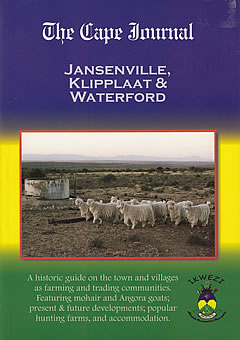Jansenville - Hub of the Mohair Industry
Monday, 20th November 2017
The beautiful mohair fabric comes from the Angora goat. The Angora goat originates in Asia Minor. The first shipment of these fine animals was imported from Turkey when a consignment of twelve rams and one ewe arrived in South Africa in 1838.
Tradition has it that the rams had been rendered infertile before leaving Turkey but that happily the ewe was pregnant and gave birth to a healthy ram kid during the voyage.
Although several further importations of Turkish stock were made up to 1896, the above-mentioned ewe and her kid formed the foundation of the Angora goat and mohair industry in South Africa. The first importation was destined for Caledon in the Western Cape but over the course of time they spread to the Eastern Cape where the climate and vegetation are more suited for the rearing of Angora goats and the production of high quality mohair.
The earliest Angora flock in the Jansenville district was established from high quality imported stock by William Cary Hobson at the farm Martyrsford in 1871. In due course, Jansenville and the surrounding districts became the hub of the mohair industry in South Africa and to this day the primary industry is centered on the small town of Jansenville.
This is clearly illustrated by the fact that the offices of both the South African Mohair Growers' Association and the Angora Goat Stud Breeders' Society of South Africa are located in Jansenville.
The leading Angora studs and the biggest concentration of stud breeders are found in the Jansenville district, while many of the leaders of the mohair industry hail from this area. When it was decided to establish an experimental farm for Angora goats a property was bought bordering on Jansenville because the vegetation was considered the most suitable for Angora goats.
Angora goats form the main branch of farming in the Jansenville district and, while wool and meat are also produced, the economy of the town and the district depends largely on the mohair fibre.











